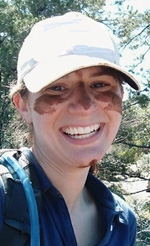
Izzo, who finished her doctorate in ecology and evolutionary biology last year at the University of Michigan, where she worked with Elizabeth Tibbetts on wasp communication and sexual selection, will speak on "Spotting the Top Male: Sexual Selection in a Lekking Paper Wasp." (Lekking means to engage in courtship displays.)
The seminar is sponsored by the Animal Behavior Graduate Group, which is hosting a series of winter-quarter seminars every Friday at noon in 6 Olson Hall. The series began Jan. 13 and will continue through March 16.
“Sexual selection has seen many advances over the past several decades, yet many questions remain,” said Izzo in her abstract. "Polistes dominulus paper wasps are a good system in which to study sexual selection, as males have a lek-based mating system and sexually dimorphic abdominal spots.
“Here, I demonstrate that these spots are used in both inter- and intra-sexual selection. Males with smaller, elliptically-shaped spots are more dominant over male rivals and are more preferred by females than males with larger, irregularly shaped spots. Additionally, the spots are condition-dependent and advertise quality.
“Further, spots function as signals: males with experimentally reduced abdominal spots win a greater proportion of fights and are preferred by females as mates over control males. Finally, female choice for attractive spots results in direct benefits to females. Females mated to males advertising high quality survive hibernation longer than females mated to males that advertise low quality. These results demonstrate that male ornaments are an important mediator of mating dynamics in paper wasps, and that females can gain direct benefits in non-economic mating systems. ”
Last summer we spotted her subject--Polistes dominulus--on a leaf in our backyard.
Lynn Kimsey, director of the Bohart Museum of Entomology and professor of entomology at UC Davis, confirmed the identification. "Note the clean black and yellow coloration and the two circular spots on the second abdominal segment," she said.
(Michigan State University has some interesting information posted on this wasp. It's an Old World Species with a native range from Europe to China. It was first discovered in the United States--Cambridge, Massachusetts--in 1981.)
About Mandy Izzo: she initially accepted a postdoctoral researcher position in the UC Davis Department of Entomology involving honey bees but is now affiliated with the UC Davis Wildlife, Fish and Conservation Biology and hopes to work on animal coloration projects.
She holds a master’s degree in biology from California State University, Northridge (2005) and a bachelor’s degree in integrative biology from UC Berkeley (2001).
Attached Images:

European paper wasp (Polistes dominulus). (Photo by Kathy Keatley Garvey)